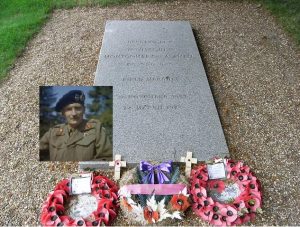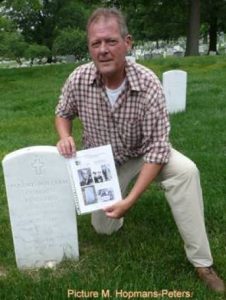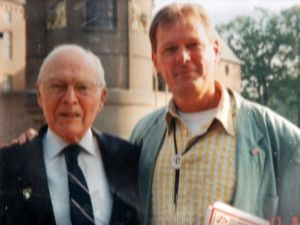Stopka, John Paul born on 14-11-1915 in Sheridan County, Wyoming,  the son of Charles L. Stopka, born 04-10-1883, in Czarny Dunajec, Neumarkt, Galicia, Austria. and Mary “Maryanna”, born Pilch Stopka, born 16-12-1896, in Wisła, Cieszyn, Katowice, Poland.. entered the military service in Wyoming. He served in the U.S. Army during the Normandy Invasion of World War II as a Major in HQ 3, 502nd Parachute Infantry Regiment, nicknames “Five-Oh-Deuce”, “The Deuce”
the son of Charles L. Stopka, born 04-10-1883, in Czarny Dunajec, Neumarkt, Galicia, Austria. and Mary “Maryanna”, born Pilch Stopka, born 16-12-1896, in Wisła, Cieszyn, Katowice, Poland.. entered the military service in Wyoming. He served in the U.S. Army during the Normandy Invasion of World War II as a Major in HQ 3, 502nd Parachute Infantry Regiment, nicknames “Five-Oh-Deuce”, “The Deuce”  under command of Lieutenant Frank Lewis Lillyman
under command of Lieutenant Frank Lewis Lillyman

 101st Airborne “Screaming Eagles”.John Stopka also was a liberator of Holland and my hometown Eindhoven
101st Airborne “Screaming Eagles”.John Stopka also was a liberator of Holland and my hometown Eindhoven  during Operation Market Garden.
during Operation Market Garden.
Franl Lewis  went on to have a long military career, which began in 1933. First serving in Hawaii and China followed by recruiting in Syracuse. He eventually went on to serve in the Korean and Vietnam War before retiring as a Lieutenant Colonel in 1968. He passed away on 06-03-1971, age 55, in Winston, Culpeper County, Virginia. Lillyman, a paratrooper and commanding officer of the 101st Pathfinder Company (Provisional), 502nd Parachute Infantry Regiment, 101st Airborne Division, was the first soldier of the Allied invasion to hit French soil just after midnight on June 6th. After jumping out of a C47, piloted by Lieutenant Colonel Joel Lee Crouch, nickname Joe Colonel Joe
went on to have a long military career, which began in 1933. First serving in Hawaii and China followed by recruiting in Syracuse. He eventually went on to serve in the Korean and Vietnam War before retiring as a Lieutenant Colonel in 1968. He passed away on 06-03-1971, age 55, in Winston, Culpeper County, Virginia. Lillyman, a paratrooper and commanding officer of the 101st Pathfinder Company (Provisional), 502nd Parachute Infantry Regiment, 101st Airborne Division, was the first soldier of the Allied invasion to hit French soil just after midnight on June 6th. After jumping out of a C47, piloted by Lieutenant Colonel Joel Lee Crouch, nickname Joe Colonel Joe  at 120mph with a lit cigar in his mouth – his “pet superstition” – Lillyman led an 18-man unit onto Utah Beach.
at 120mph with a lit cigar in his mouth – his “pet superstition” – Lillyman led an 18-man unit onto Utah Beach. Standing L to R: Nav Captain William Culp, Pilot Lieutenant Colonel Joel L Crouch, Radio Cpl Harold E Coonrod,…
Standing L to R: Nav Captain William Culp, Pilot Lieutenant Colonel Joel L Crouch, Radio Cpl Harold E Coonrod,…
Market Garden was a risky plan by British Field Marshal Bernard Montgomery.  It would be the first great daylight air assault attempted by a military power since Germany’s Fallschirmjaegers attack Crete. Similar to the Germans assault of four years earlier, the Allies initial plan for September 17,-1944 was to use the paratroopers and glidermen of the 82nd
It would be the first great daylight air assault attempted by a military power since Germany’s Fallschirmjaegers attack Crete. Similar to the Germans assault of four years earlier, the Allies initial plan for September 17,-1944 was to use the paratroopers and glidermen of the 82nd  under command of James Maurice “Slim Jim” Gavin
under command of James Maurice “Slim Jim” Gavin  and 101st U.S. Airborne Divisions
and 101st U.S. Airborne Divisions  under command of Maxwell Davenport Taylor
under command of Maxwell Davenport Taylor  and England’s First Airborne Division
and England’s First Airborne Division  under command of General Robert Elliot “Roy” Urqhart
under command of General Robert Elliot “Roy” Urqhart 
 in a daring daylight drop into Holland. The airborne Allied troops were to seize roads, bridges and the key communication cities of Eindhoven, Nijmegen and Arnhem, thus cutting Holland in half and clearing a corridor for British armoured and motorized columns all the way to the German border. The 101st mission was to secure the fifteen miles of Hell’s Highway stretching from Eindhoven north to Veghel. After less than three months in England, the 502nd was to make its second combat jump. Still under the command of Colonel John Hersey Michaelis
in a daring daylight drop into Holland. The airborne Allied troops were to seize roads, bridges and the key communication cities of Eindhoven, Nijmegen and Arnhem, thus cutting Holland in half and clearing a corridor for British armoured and motorized columns all the way to the German border. The 101st mission was to secure the fifteen miles of Hell’s Highway stretching from Eindhoven north to Veghel. After less than three months in England, the 502nd was to make its second combat jump. Still under the command of Colonel John Hersey Michaelis  who died in 1985 at the age of 73 in Clayton, Georgia, from a heart attack, the unit was to land in Holland on DZ C, seize the small highway bridge over the Dommel River north of Saint Oedenrode and the railroad and road bridges at Best. The 502nd was also given the mission of guarding DZs B & C for the subsequent glider landings. Shortly after 1315 hours on the afternoon of 17 September 1944, after an uneventful daylight drop, the men of the 502nd gathered up and headed for their objectives.First Battalion went north to capture the little town of St Oedenrode. Third Battalion sent patrols through the Zonsche forest, trying to move toward the town of Best and the bridge. German resistance was tough in the vicinity of Best but the 502nd fought their way to within 100 yards of the bridge before the Germans blew it up. In fierce fighting around the bridge, Private Joe Eugen Mann
who died in 1985 at the age of 73 in Clayton, Georgia, from a heart attack, the unit was to land in Holland on DZ C, seize the small highway bridge over the Dommel River north of Saint Oedenrode and the railroad and road bridges at Best. The 502nd was also given the mission of guarding DZs B & C for the subsequent glider landings. Shortly after 1315 hours on the afternoon of 17 September 1944, after an uneventful daylight drop, the men of the 502nd gathered up and headed for their objectives.First Battalion went north to capture the little town of St Oedenrode. Third Battalion sent patrols through the Zonsche forest, trying to move toward the town of Best and the bridge. German resistance was tough in the vicinity of Best but the 502nd fought their way to within 100 yards of the bridge before the Germans blew it up. In fierce fighting around the bridge, Private Joe Eugen Mann

 who was seriously wounded twice during the fighting, was killed when he threw himself on a German grenade to save his fellow soldiers who were in the same foxhole with him. Mann was posthumously awarded the Medal of Honor for this act of selfless heroism. A Monument has been errected for this hero, in The Netherlands.
who was seriously wounded twice during the fighting, was killed when he threw himself on a German grenade to save his fellow soldiers who were in the same foxhole with him. Mann was posthumously awarded the Medal of Honor for this act of selfless heroism. A Monument has been errected for this hero, in The Netherlands.  The only other Medal of Honor recipient of 101st during the war, Colonel. Robert George Cole,
The only other Medal of Honor recipient of 101st during the war, Colonel. Robert George Cole, 

 was shot and killed by a snipers bullet in the action around the Zonsche Forest. The third battalion was now in the capable hands of its executive officer Major John Stopka. On 22 September, Lieutenant Colonel Michaelis and three of his staff were seriously wounded by an artillery shell outside of his headquarters, so the command of the 502nd PIR passed to the 2nd Battalion commander, Steve Chappuis
was shot and killed by a snipers bullet in the action around the Zonsche Forest. The third battalion was now in the capable hands of its executive officer Major John Stopka. On 22 September, Lieutenant Colonel Michaelis and three of his staff were seriously wounded by an artillery shell outside of his headquarters, so the command of the 502nd PIR passed to the 2nd Battalion commander, Steve Chappuis 
 . After fierce battle the 502nd secured their objectives. The 502nd now moved north with the rest of the 101st to relieve the defensive positions on ‘The Island’, on the opposite side of the Neder-Rijn. Under constant artillery barrages from the germans on the ‘Arnhem-side’ of the river the 101st would fight some of its toughest battles during its time in Holland. As one veteran puts it: ‘The only good thing about The Island were the happy liberated people we met on our way in, and the almost dayly rations on British Rum we received…’ Market Garden didn’t ‘close’ the war before Christmas, as Montgomery suspected it to do. It almost wiped out the British Paratroopers that landed near Arnhem. Their Polish comrades also suffered great losses. A great mutual respect grow between the English, Canadian, Polish and US Paratroopers.
. After fierce battle the 502nd secured their objectives. The 502nd now moved north with the rest of the 101st to relieve the defensive positions on ‘The Island’, on the opposite side of the Neder-Rijn. Under constant artillery barrages from the germans on the ‘Arnhem-side’ of the river the 101st would fight some of its toughest battles during its time in Holland. As one veteran puts it: ‘The only good thing about The Island were the happy liberated people we met on our way in, and the almost dayly rations on British Rum we received…’ Market Garden didn’t ‘close’ the war before Christmas, as Montgomery suspected it to do. It almost wiped out the British Paratroopers that landed near Arnhem. Their Polish comrades also suffered great losses. A great mutual respect grow between the English, Canadian, Polish and US Paratroopers.
Death and burial ground of Stopka John Paul.

 Despite several determined German attacks, the perimeter held. The German commander, Generalleutnant Heinrich Freiherr von Lüttwitz,
Despite several determined German attacks, the perimeter held. The German commander, Generalleutnant Heinrich Freiherr von Lüttwitz,  requested Bastogne’s surrender. When General Anthony Clement “Nuts” McAuliffe,
requested Bastogne’s surrender. When General Anthony Clement “Nuts” McAuliffe, 
 now acting commander of the 101st, was told, a frustrated McAuliffe responded, “Nuts!” After turning to other pressing issues, his staff reminded him that they should reply to the German demand. One officer (Harry William. Osborn. Kinnard,
now acting commander of the 101st, was told, a frustrated McAuliffe responded, “Nuts!” After turning to other pressing issues, his staff reminded him that they should reply to the German demand. One officer (Harry William. Osborn. Kinnard,

 then a lieutenant colonel) recommended that McAuliffe’s initial reply should be “tough to beat”. Thus McAuliffe wrote on the paper delivered to the Germans: “NUTS!” That reply had to be explained, both to the Germans and to non-American Allies.[notes Both of the two panzer divisions of the XLVII Panzer Corps moved forward from Bastogne after December 21, leaving only one panzergrenadier regiment of the Panzer-Lehr-Division
then a lieutenant colonel) recommended that McAuliffe’s initial reply should be “tough to beat”. Thus McAuliffe wrote on the paper delivered to the Germans: “NUTS!” That reply had to be explained, both to the Germans and to non-American Allies.[notes Both of the two panzer divisions of the XLVII Panzer Corps moved forward from Bastogne after December 21, leaving only one panzergrenadier regiment of the Panzer-Lehr-Division  under command of Lieutenant-General Fritz Herman Bayerlein
under command of Lieutenant-General Fritz Herman Bayerlein

 to assist the 26th Volksgrenadier Division under command of Generalmajor Heinz Kokott
to assist the 26th Volksgrenadier Division under command of Generalmajor Heinz Kokott  in attempting to capture the crossroads. Generalmajor Heinz Kokott survived the war and died 29-05-1976 (aged 75) in Traunstein. The 26th VG received additional armor and panzergrenadier reinforcements on Christmas Eve to prepare for its final assault, to take place on Christmas Day. Because it lacked sufficient armor and troops and the 26th VG Division was near exhaustion, the XLVII Panzer Corps concentrated the assault on several individual locations on the west side of perimeter in sequence rather than launching one simultaneous attack on all sides. The assault, despite initial success by German tanks in penetrating the American line, was defeated and virtually all of the German tanks involved were destroyed. The next day, December 26, the spearhead of General George Smith Patton’s
in attempting to capture the crossroads. Generalmajor Heinz Kokott survived the war and died 29-05-1976 (aged 75) in Traunstein. The 26th VG received additional armor and panzergrenadier reinforcements on Christmas Eve to prepare for its final assault, to take place on Christmas Day. Because it lacked sufficient armor and troops and the 26th VG Division was near exhaustion, the XLVII Panzer Corps concentrated the assault on several individual locations on the west side of perimeter in sequence rather than launching one simultaneous attack on all sides. The assault, despite initial success by German tanks in penetrating the American line, was defeated and virtually all of the German tanks involved were destroyed. The next day, December 26, the spearhead of General George Smith Patton’s 
 U.S. Third Army
U.S. Third Army  relief force, the 4th Armored Division, broke through the German lines and opened a corridor to Bastogne, ending the siege. The division got the nickname “The Battered Bastards of the Bastion of Bastogne”.
relief force, the 4th Armored Division, broke through the German lines and opened a corridor to Bastogne, ending the siege. The division got the nickname “The Battered Bastards of the Bastion of Bastogne”.
The casualties of the 101 Airborne Division during their European campaign: total battle casualities 9.328, killed in action 1.766, wounded in action 6.388, missing in action 207 and prisoner of war 967.
Major John P Stopka died in battle 14-01-1945, age 29, near Michamps. Belgium and is buried at the Luxembourg American Cemetery, Luxembourg City, Luxembourg. Plot: E, Row: 9, Grave: 38. 50 Val du Scheid, 2517 Luxembourg, Luxemburg.






















Leave a Reply